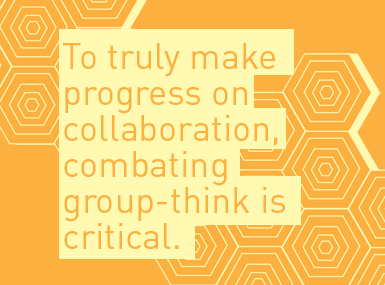July 7, 2015
Collaboration is a powerful concept in the public sector – often talked about and highly valued, but rarely achieved.
When done well, collaboration can lead to integrated, thoughtful solutions to challenging problems. When done poorly, it can waste time and resources. Many of society’s most challenging problems – climate change, unemployment, poverty – would benefit if governments were to operate on a more collaborative basis; with more internal coordination (inter-departmental collaboration), better cooperation with other levels of government (inter-governmental collaboration), and with more effective external partnerships (inter-sectoral collaboration).
To promote more effective collaboration, governments should focus on three areas:
1. Physical and digital space
The Challenge:
- Collaboration requires access to the right people and right information on a given topic to nurture a shared understanding of issues. Traditional government systems and spaces are designed in ways that too often hamper good collaboration rather than facilitating it. As a result, people often miss the opportunity to benefit from the previous work of others – needlessly duplicating work already done or, worse, replicating past mistakes.
Traditional government systems and spaces are designed in ways that too often hamper good collaboration rather than facilitating it.
Solutions:
- In order for people to pull in the same direction on challenging files, obstacles to the free flow of information must be removed. Technology can play a vital role in this transformation by enabling systems that are open across departments or governments, allowing people to work jointly on projects in multiple locations. The federal government is looking to modernize its current technology platforms, GCPedia and GCconnex, to bolster transparency and better share information in an increasingly digital world. More advanced tools, like Github, can further enable collaboration across separations of time and space, and have been used effectively to manage open data, develop legislation and facilitate complex procurement arrangements.
- Thinking about how space is designed is also important. Casual exchanges and informal group work are highly valued as ways to encourage creative collaboration. AT&T’s innovative Bell Labs designed its buildings to increase the frequency of unplanned interactions among researchers, by having long corridors. A cost-effective approach to collaboration-by-design could involve temporary ‘hoteling’ spaces with staff working on similar issues from different departments to spark more discussion and creativity.
2. People and culture
The Challenge:
- Organizational culture has a major influence on collaboration. Public sector culture tends to be risk averse, particularly when it comes to sharing information. While this may make sense given the adverse consequences of unwanted media or stakeholder attention, such a cautious mindset can hamper collaboration and preclude benefitting from the expertise of partners.

Solutions:
- Promoting the free flow of ideas between government and other sectors is a vital step in establishing a civil service culture of collaboration. In the UK, a government program offering secondments between the public and private sector aims to strengthen connections between the two. In Canada, the federal government’s Interchange program follows a similar model, though the number of new assignments has fallen dramatically in recent years. Flexible staffing is also used in some cases to develop greater collaborative capabilities by using pools of staff that can be moved around the department or assigned to emerging issues as necessary.
- Another way to encourage a collaborative culture is to embed it in performance evaluation, such as developing commitments to work more with others and associated incentives. An inter-personal commitment to collaboration during the performance review process is more likely to yield results than broad encouragement with no clear roadmap. Developing more ‘tri-sector athletes’ who understand issues from a broad perspective should be a key priority for all governments that want to develop more integrated, holistic solutions for wicked policy problems.
Safe spaces are needed to provide opportunities not only for partners to talk with each other, but also to test ideas and design potential solutions from an end-user perspective.
3. Innovation labs
The Challenge:
- To truly make progress on collaboration, combating group-think is critical. One way to accomplish this is creating a venue to encourage discussion of unpopular or risky options to ensure policy solutions are stress-tested before they are scaled up. Designing opportunities for information-sharing and fostering a culture that enables greater engagement are good first steps toward strengthened collaboration, but specific models that put these concepts into practice are also required.
Solution:
- Innovation (or design) labs physically bring together people from different sectors and disciplines to consider problems, brainstorm solutions and rapidly test ideas. Concepts that don’t work are discarded, while those that do are brought to market. This model is used by governments including Denmark’s cross-ministerial MindLab which has tackled complex challenges, such as reducing red tape for taxpayers, by providing public servants with a specific space to innovate. The federal government recently launched its own innovation lab while the Ontario government is a partner in the MaRS Solutions Lab.
- These labs are valuable because failure is designed into the process. This is counterintuitive to conventional government thinking, which typically calls for collaboration and innovation – but does not want accept that errors must occur to actually be innovative. Safe spaces are needed to provide opportunities not only for partners to talk with each other, but also to test ideas and design potential solutions from an end-user perspective.
More related to this topic
Authors
Sunil Johal
Sara Ditta
Release Date
July 7, 2015







